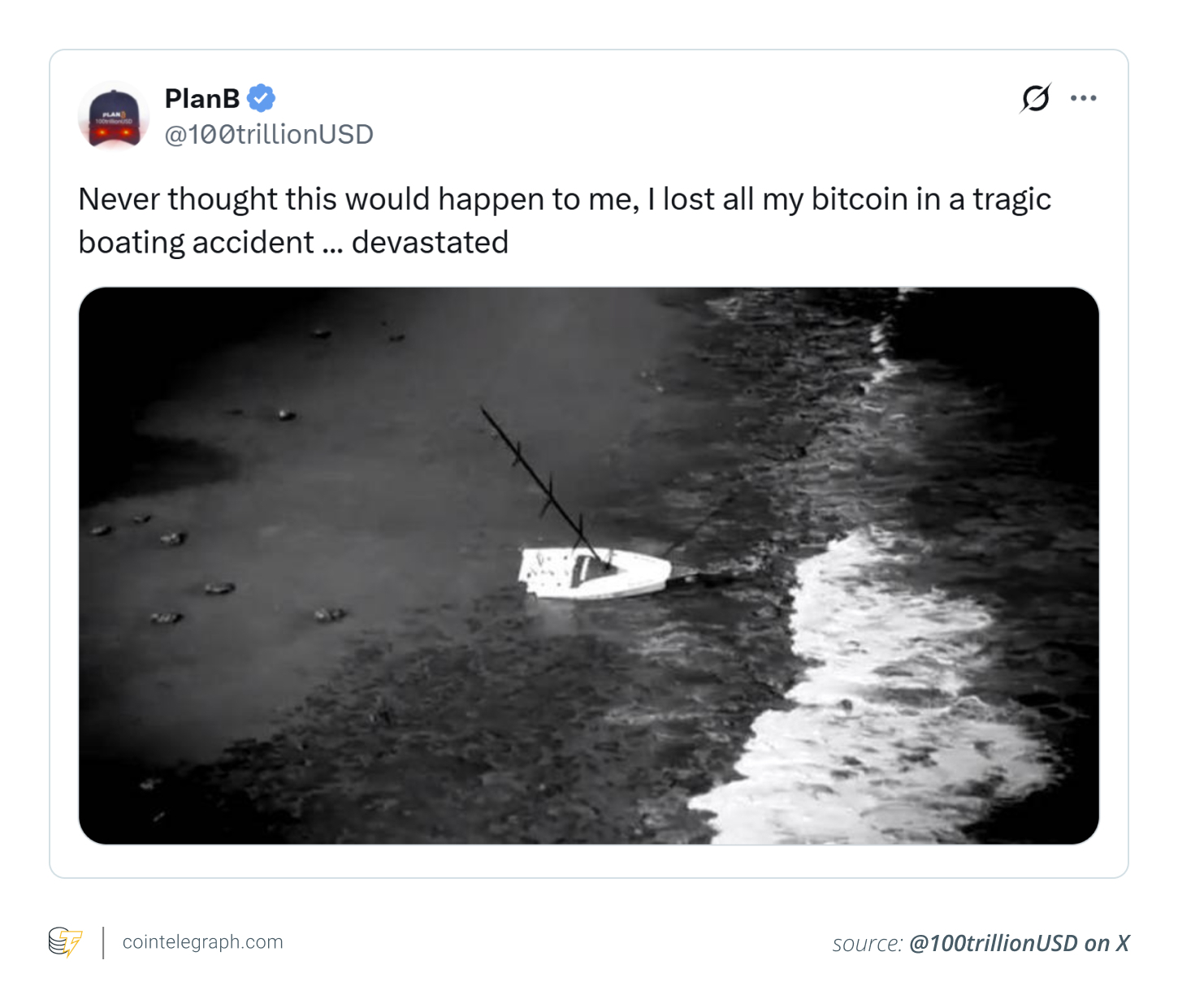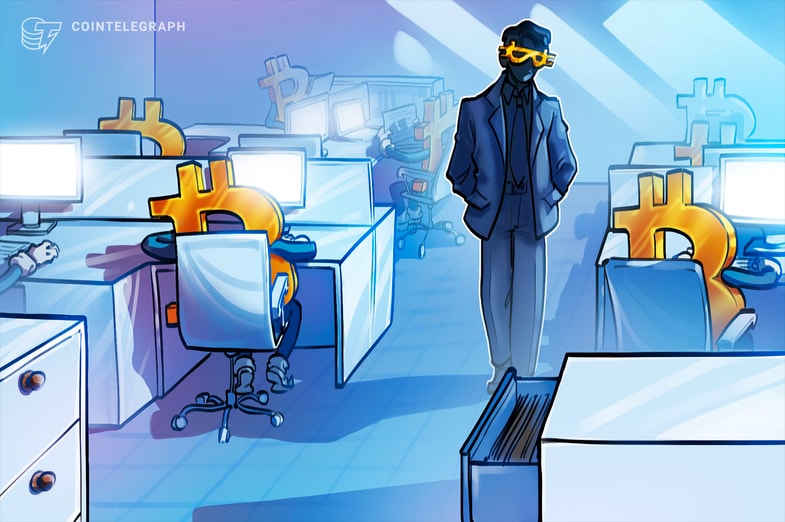A chief executive officer for Bitcoin? It couldn’t sound more ironic, considering Bitcoin was created as a distributed system without a central control. The founders forged it and walked away.
Bitcoin doesn’t need a marketing department and, therefore, doesn’t fall prey to greedy marketing leaders who use dubious tactics to promote it. It runs and thrives without the leadership of anybody in particular.
By stepping away from the project, Satoshi Nakamoto removed human corruption from the project. It’s become the robust and incorruptible system the world knows because it’s simple, programmable and elegant without any specific human intervention other than a network of computers that support and advance it.
What if, though, Satoshi Nakamoto returned from anonymity and revealed themselves by moving the 1 million Bitcoin (BTC) stuck in a dormant wallet since 2011?

The one million BTC in Satoshi’s wallet (worth roughly $81 billion as of April 11, 2025) is a big deal because it is proof that Satoshi fulfilled their role in creating the most disruptive technology since the internet. They then made the shocking move of disappearing and leaving the project in the hands of future developers.
Moving those coins would mean they’re still out there. They could reclaim that million Bitcoin, drop the price, and cause the largest rug pull ever.
Yet Satoshi could come back to fix Bitcoin because it’s taken a questionable direction since they left the project.
This article muses on what a day in the life of an imaginary Satoshi as Bitcoin CEO would look like. Would Bitcoin collapse under the weight of a centralized figurehead, undermining its core principle of decentralization?
Or might it follow a new path as an alternative currency that complies with regulations and minimizes volatility? Let’s explore adding a little spice to this Bitcoin satire in 2025.
Did you know? Satoshi mined between 900,000 and 1.1 million BTC in the early days of the network. Their wallets stay inactive since 2011. Moving those coins would upset the whole Bitcoin ecosystem.
Bitcoin isn’t a company — But what if it ran like one?
One of the most valuable criteria intrinsic to Bitcoin is its leaderless resilience. Satoshi Nakamoto designed a network that required distributed and decentralized governance. This setup stops a leader, like a CEO, from being a single point of failure. It also makes it harder for authorities to target or prosecute if there’s nobody in charge.
Bitcoin blockchain isn’t a company; it’s tech like the internet. Could you imagine the internet with a CEO?
For these reasons, a Bitcoin CEO is unimaginable — especially if that CEO were Satoshi. But just for a moment, let’s imagine Bitcoin as a company and Satoshi as its CEO for a single day.
Many would view their comeback as a reassurance that now Bitcoin is in good hands. It can finally become the alternative digital currency that aims to disrupt the world’s dollar dominance. Some might see it as a project failure. That’s because one person’s control goes against Bitcoin’s core principle.

What would they be doing as CEO of the most disruptive tech since the birth of the internet? Let’s take a little turn into imagination and fantasize about Satoshi being alive and active in Bitcoin’s development.
Did you know? Satoshi Nakamoto was nominated for the Nobel Prize in 2015 by Bhagwan Chowdhry, a professor of finance at UCLA Anderson School. Being an anonymous person, Satoshi could not receive the prize, but the symbolic act galvanized the community during that time.
A day in the life of Satoshi (as CEO)
Imagine, in 2025, Satoshi Nakamoto makes a surprise return — not as a myth, but as the CEO of Bitcoin Inc, a hypothetical entity born from collective imagination.
On their first day back, Satoshi begins with a press statement that stuns the financial world: They lost their wallets and access to their Bitcoin in a boat accident. Therefore, they’re not rich; they live a simple life in their 50s (a middle-aged cryptographer), away from the buzz and retired in the secluded countryside.

They’ve never liked fame and popularity, so they keep a low profile, trying to maintain their sanity and privacy.
After returning to fix Bitcoin, they made contact with all the developers and are now working closely to resolve the scalability issue. They say it will take years, maybe decades, but Bitcoin’s concerns with high fees and speed will become a memory of the past.
This will spark a new way to use Bitcoin. There’s no need for a “new Bitcoin” that claims to be faster or better.
Satoshi is no longer using Bitcointalk as a communication tool. They have now shifted all decision-making to X. Here, debates heat up about the next Taproot release and how to make the Lightning Network more user-friendly and efficient.
With a cup of coffee in their hands, Satoshi would check the node they’re running and make sure the network is healthy and running as usual. Then audit the code and work on some bugs before moving to technical research on quantum computers to save Bitcoin from them.
Mid-morning is for online meetings — with the new de facto chief marketing officer, Larry Fink. There’s currently no better person to promote the Bitcoin project. Fink strongly believes in it and has done a better job than Elon Musk could ever do; therefore, the choice for CMO was irrefutable. With Michael Saylor as the chief financial officer and Adam Back as the chief technology officer, the team is now complete and ready to prosper.

Together, they’re Bitcoin’s dream team — or nightmare, depending on which corner of crypto you ask.
Bitcoin leadership now has a face. And the weight of that is not lost on Satoshi. The responsibility of the CEO is enormous. At the end of the day, they’re trying to save the world here!
Satoshi would spend the rest of the day reflecting on what has gone wrong since he left and how the Bitcoin community could prioritize institutional adoption over privacy.
That was one big mistake. Satoshi had always been a great advocate for privacy. Revealing their identity to step in and help was a massive sacrifice, but one they admit had to be made.
Calling for bigger blocks, regulatory nightmares, higher fees, limited speed and observing growing centralization in mining companies, all of this was driving them so insane that they had to intervene.
Finally, they check Bitcoin’s price, but that’s not their main concern during the day. The markets are holding steady despite a hawkish US Federal Reserve and another wave of tariffs. But as always, the price isn’t the point.
The mission remains the same: Give humanity a tool for liberation.
Did you know? While it’s hard to keep track of every individual who has ever been rumored or claimed to be Satoshi Nakamoto, the most notorious is Craig Wright and his failed, awkward attempt to prove in court he was Nakamoto.
No CEO, no problem? Why Satoshi’s disappearance still protects Bitcoin
This was a fictional Bitcoin story. In reality, Satoshi Nakamoto disappeared from the public eye and retired from the Bitcoin project as early as April 2011. They left a simple but now iconic message on the Bitcoin forum page: “I’ve moved on to other things. Bitcoin is in good hands with Gavin and everyone.”
And they never came back. Nobody knows what happened to them; most believe they died. Many have tried — and continue to try — to uncover the identity of Satoshi Nakamoto.
From courtroom claims to government investigations, the search hasn’t stopped. But some of Bitcoin’s earliest voices believe the mystery is exactly what makes Bitcoin work.

A lawyer has recently sued the US government, claiming the government is aware of Nakamoto’s identity. US Department of Homeland Security Special Agent Rana Saoud spoke to four people linked to creating Bitcoin. This is what she declared: “The agents flew to California, and they realized that he wasn’t alone in creating this; there were three other people. They sat down and talked with them to find out how this actually works and what the reason for it was,” Saoud said in a presentation, which is available on YouTube.
The mystery of Satoshi Nakamoto shields Bitcoin from central points of failure. It prevents cults of personality and reinforces the idea that no one is in charge — which is precisely the point. Would revealing Satoshi help or hurt? That question still lingers. But for now, the mystery endures — and so does Bitcoin.
A Bitcoin CEO could dramatically influence market perception. Depending on their presence and charisma, it could all go spectacularly right — or terribly wrong. Missteps or controversy could damage their reputation and trigger a crash. On the flip side, a credible, visionary leader might boost confidence, spark price surges, and reshape the narrative around Bitcoin.
Satoshi’s disappearance was likely a deliberate move to prevent exactly that — to ensure no single figure could become a point of failure or control. After all, one leader could jeopardize the most revolutionary technology since the birth of the internet.
So, is the future truly decentralized?
Maybe that depends on whether one can accept a world-changing system with no one in charge.



